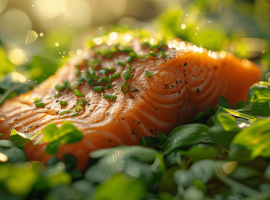It’s a pleasure to eat sushi.
A delicious, flavorful experience awaits you whenever you eat sushi, whether you prefer traditional rolls or fresh sashimi and nigiri. It can be confusing to eat sushi if you’ve never done it before – you may feel nervous and not know how to eat it properly if you’ve never tried sushi.
The first thing you should know is that sushi can be eaten in a variety of ways. Do not be put off by snobbish people who may look down on you for ordering a California roll or choosing whatever sauce you like. Eating is about enjoying yourself and eating delicious food – not impressing others with your palate.
The process of eating sushi can still seem confusing at first. Are chopsticks necessary? Are there any dips you need to use on sushi? Would it be okay if you used your hands? A beginner should try what roll?
Our team has answers to your questions. You’re in luck if you’re curious about how to eat sushi, as well as the culture behind it. This guide will cover the basics of sushi eating – these tips might surprise sushi experts.
Getting hooked on sushi isn’t hard if you know how. Here, we will walk you through all the essential information about sushi, and provide some helpful tips for making your sushi eating experience as enjoyable as possible.
So what’s Sushi?
In sushi, rice is mixed with sashimi fish, seaweed, or whatever else is available. Sushi rice is essential to the definition of sushi.
Taking Sushi to the Next Level
The setup for a sushi restaurant will vary based on its location, which makes it different each time. In the world of sushi, sushi chefs have certain unwritten guidelines.
Your chosen sushi or rolls will be on a plate for you to enjoy. Besides chopsticks, you may receive an additional appetiser plate and a bottle of soy sauce.
The most common way to eat sushi is with chopsticks, although you can also eat it with your hands. If you aren’t comfortable using chopsticks, you can use a fork instead. No one will be insulted by that.
Sushi restaurants usually have extra items such as miso soup, ginger dressing, and egg rolls. You’ll have to ask the sushi bar.
You will usually find three things on your plate:
- Your choice of sushi rolls
- Green paste Wasabi generously dabbed on
- Fresh ginger pickled
Bringing Your Flavors into Balance
Why do sushi rolls come with ginger and wasabi? Now let’s look at how sushi is best eaten – and then we can discuss how to properly do it.
The wasabi is a spicy condiment somewhat like horseradish, but it does not have the heat of hot pepper. The burn and heat are soothing, yet they don’t last long. Wasabi is often mixed with soy sauce by those looking for a more intense flavour.
Pickled ginger, however, serves a different purpose. You can eat pickled ginger to alleviate the burning sensation caused by horseradish, and it neutralizes the taste of the last sushi roll, preparing you for the next meal.
Let’s take a look at how sushi is eaten traditionally. This is what you will do!
- You will be served sushi by the chef or server.
- On a plate or in a bowl, pour a small amount of soy sauce.
- Take a piece of sushi and dip it in soy sauce. Add a bit more wasabi to your sushi using your chopsticks if you like your sushi spicy.
- Sushi is good for you. It is recommended that you eat small pieces, such as nigiri and sashimi, all at once, however, larger pieces, such as American-style rolls, should be eaten in small bites.
- Make sure you chew the sushi thoroughly so the flavour can spread throughout.
- You might want to take a sip of sake now while you’re eating sushi.
- Grasp some pickled ginger from your plate and munch on it. In between each bite or roll, do this. By doing this, you can get rid of the aftertaste of sushi roll flavour on your palate.
- Then repeat the process for as long as you can eat sushi or as long as supplies last.
It’s that simple! It is important to follow these basic rules when enjoying sushi. The following rules are not mandatory, so you are free to ignore them if you wish. Sushi can be eaten any way you like. It won’t matter. It is enjoyable following traditions, particularly when you’re eating something as classic as sushi, however, following these guidelines will enhance the flavour of your dish.
Sushi’s Most Popular Fish
Sushi can be made with just about any fish. Crab, octopus, shrimp, and salmon are among the most popular fish. There are a variety of other exotic ingredients available, such as sweetfish, swordfish, and eel. Modern sushi rolls commonly contain the following types of fish:
- Abalone
- Ark shell
- Blue marlin
- Clams
- Cockle
- Crab
- Eel
- Flatfish
- Halfbeak
- Mackerel
- Octopus
- Salmon
- Sea bream
- Seabass
- Scallop
- Shrimp
- Squid
- Sweetfish
- Swordfish
- Trout
- Tuna
- Yellowtail
If you aren’t sure about a roll’s fish or ingredients, just ask! Different names may be given to these ingredients, or their Japanese names may be used.
If you’re unsure what fish you’ll like, order one with trout, salmon, or tuna. Alternatively, you might like to try fish that you haven’t tried before. When eating sushi, you can taste the true raw flavour of the fish, which may be the best way to try new fish.
Sashimi: what is it?
Sashimi is a raw fish dish that is sliced thinly and eaten raw. As with most seafood, sashimi is usually consumed alone with wasabi, ginger pickles, and soy sauce.
Frequently, we are asked if the fish is sushi grade. Is sushi grade that important? The term sushi grade refers to high-quality fish suitable for sashimi and sushi. Since sushi and sashimi are eaten raw, sauces and the cooking process cannot mask their taste and texture. Fresh fish should not have any marks or blemishes, and it should also have a pleasant smell and taste, without being fishy. Basically, sushi-grade fish is top-notch seafood handled with care during its journey through the ocean to your plate.
Most British customers believe that there is a reputable international seafood agency for certifying sushi-grade fish. Throughout the Western sushi industry, sushi grade is becoming increasingly popular. Product labelling is the retailer’s and wholesaler’s duty.
How fish is handled before being sold to the public is no longer up to the retailers. Sushi and sashimi sold within the EU must first be frozen within 24 hours at or below minus 20°C before being served raw. Since we’re 100% frozen, it fits perfectly into our approach.
A Guide to Sushi
If you don’t eat raw fish or sashimi, you’ll consume sushi rolls. As sashimi is simply raw fish slices, nigiri is raw fish with rice, so it would be a good choice for beginners. Often, rolls come with cooked fish and other ingredients, which makes them easier to eat.
Seaweed and rice are the basic ingredients of all sushi rolls. There are many kinds of sushi rolls, but sushi chefs distinctively make them.
Having trouble deciding? We’ve compiled a list of delightful sushi for beginners.
- Boston roll – A cucumber, shrimp, and avocado roll.
- California roll – a combination of imitation crab, avocado, and cucumber. You don’t need to worry about the crab being raw – it is cooked.
- King crab roll – a mayonnaise-based roll with king crab meat.
- Philadelphia roll – cream cheese, salmon, and avocado.
- Spicy tuna roll – a tuna roll combined with spicy mayo.
- Spider roll – soft-shell crab tempura, cucumber, avocado, and spicy mayonnaise.
Do you have a problem eating raw fish? Be on the lookout for anything labelled “tempura,” which is a batter-dipped breaded seafood dish. Shrimp tempura roll, fish tempura, whichever is available. When added to sushi rolls, the fish adds a delicious flavour and is fully cooked, with a crisp texture.








